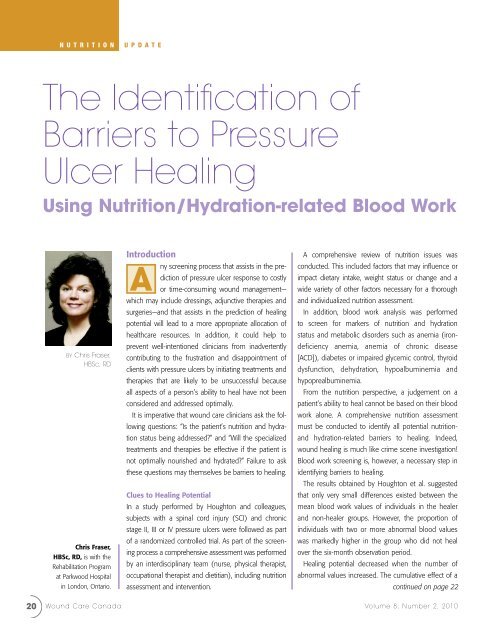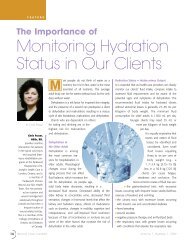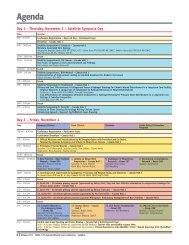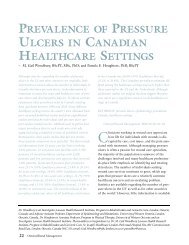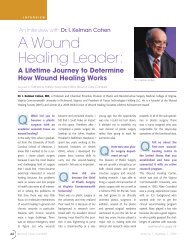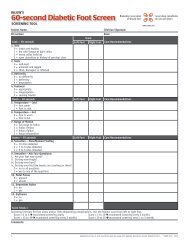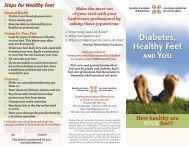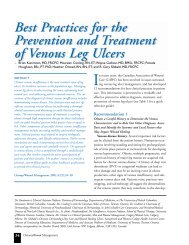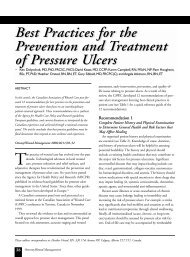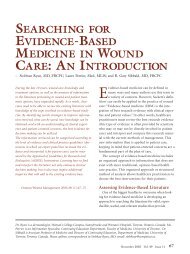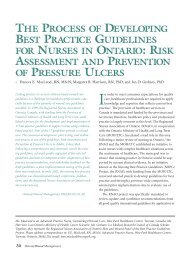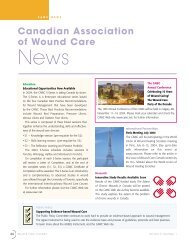Bilateral Lower Limb Lymphedema Secondary to Morbid Obesity
Bilateral Lower Limb Lymphedema Secondary to Morbid Obesity
Bilateral Lower Limb Lymphedema Secondary to Morbid Obesity
Create successful ePaper yourself
Turn your PDF publications into a flip-book with our unique Google optimized e-Paper software.
20<br />
N U T R I T I O N U P D A T E<br />
The Identification of<br />
Barriers <strong>to</strong> Pressure<br />
Ulcer Healing<br />
Using Nutrition/Hydration-related Blood Work<br />
BY Chris Fraser,<br />
HBSc, RD<br />
Chris Fraser,<br />
HBSc, RD, is with the<br />
Rehabilitation Program<br />
at Parkwood Hospital<br />
in London, Ontario.<br />
Introduction<br />
A<br />
ny screening process that assists in the prediction<br />
of pressure ulcer response <strong>to</strong> costly<br />
or time-consuming wound management—<br />
which may include dressings, adjunctive therapies and<br />
surgeries—and that assists in the prediction of healing<br />
potential will lead <strong>to</strong> a more appropriate allocation of<br />
healthcare resources. In addition, it could help <strong>to</strong><br />
prevent well-intentioned clinicians from inadvertently<br />
contributing <strong>to</strong> the frustration and disappointment of<br />
clients with pressure ulcers by initiating treatments and<br />
therapies that are likely <strong>to</strong> be unsuccessful because<br />
all aspects of a person’s ability <strong>to</strong> heal have not been<br />
considered and addressed optimally.<br />
It is imperative that wound care clinicians ask the following<br />
questions: “Is the patient’s nutrition and hydration<br />
status being addressed?” and “Will the specialized<br />
treatments and therapies be effective if the patient is<br />
not optimally nourished and hydrated?” Failure <strong>to</strong> ask<br />
these questions may themselves be barriers <strong>to</strong> healing.<br />
Clues <strong>to</strong> Healing Potential<br />
In a study performed by Hough<strong>to</strong>n and colleagues,<br />
subjects with a spinal cord injury (SCI) and chronic<br />
stage II, III or IV pressure ulcers were followed as part<br />
of a randomized controlled trial. As part of the screening<br />
process a comprehensive assessment was performed<br />
by an interdisciplinary team (nurse, physical therapist,<br />
occupational therapist and dietitian), including nutrition<br />
assessment and intervention.<br />
A comprehensive review of nutrition issues was<br />
conducted. This included fac<strong>to</strong>rs that may influence or<br />
impact dietary intake, weight status or change and a<br />
wide variety of other fac<strong>to</strong>rs necessary for a thorough<br />
and individualized nutrition assessment.<br />
In addition, blood work analysis was performed<br />
<strong>to</strong> screen for markers of nutrition and hydration<br />
status and metabolic disorders such as anemia (irondeficiency<br />
anemia, anemia of chronic disease<br />
[ACD]), diabetes or impaired glycemic control, thyroid<br />
dysfunction, dehydration, hypoalbuminemia and<br />
hypoprealbuminemia.<br />
From the nutrition perspective, a judgement on a<br />
patient’s ability <strong>to</strong> heal cannot be based on their blood<br />
work alone. A comprehensive nutrition assessment<br />
must be conducted <strong>to</strong> identify all potential nutritionand<br />
hydration-related barriers <strong>to</strong> healing. Indeed,<br />
wound healing is much like crime scene investigation!<br />
Blood work screening is, however, a necessary step in<br />
identifying barriers <strong>to</strong> healing.<br />
The results obtained by Hough<strong>to</strong>n et al. suggested<br />
that only very small differences existed between the<br />
mean blood work values of individuals in the healer<br />
and non-healer groups. However, the proportion of<br />
individuals with two or more abnormal blood values<br />
was markedly higher in the group who did not heal<br />
over the six-month observation period.<br />
Healing potential decreased when the number of<br />
abnormal values increased. The cumulative effect of a<br />
continued on page 22<br />
Wound Care Canada Volume 8, Number 2, 2010


